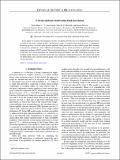Files in this item
N-strain epidemic model using bond percolation
Item metadata
| dc.contributor.author | Mann, Peter Stephen | |
| dc.contributor.author | Smith, V.A. | |
| dc.contributor.author | Mitchell, John B. O. | |
| dc.contributor.author | Dobson, Simon Andrew | |
| dc.date.accessioned | 2022-07-27T11:30:07Z | |
| dc.date.available | 2022-07-27T11:30:07Z | |
| dc.date.issued | 2022-07-20 | |
| dc.identifier | 280189666 | |
| dc.identifier | f61b92fe-2a81-4a81-86b4-48c2448e486d | |
| dc.identifier | 000834659100005 | |
| dc.identifier | 85135997395 | |
| dc.identifier.citation | Mann , P S , Smith , V A , Mitchell , J B O & Dobson , S A 2022 , ' N-strain epidemic model using bond percolation ' , Physical Review. E, Statistical, nonlinear, and soft matter physics , vol. 106 , no. 1 , 014304 . https://doi.org/10.1103/PhysRevE.106.014304 | en |
| dc.identifier.issn | 1539-3755 | |
| dc.identifier.other | ORCID: /0000-0002-0487-2469/work/116598110 | |
| dc.identifier.other | ORCID: /0000-0002-0379-6097/work/116598334 | |
| dc.identifier.other | ORCID: /0000-0001-9633-2103/work/116598389 | |
| dc.identifier.uri | https://hdl.handle.net/10023/25724 | |
| dc.description | Funding: This work was partially supported by the UK Engineering and Physical Sciences Research Council under grant number EP/N007565/1 (Science of Sensor Systems Software). | en |
| dc.description.abstract | In this paper we examine the structure of random networks that have undergone bond percolation an arbitrary, but finite, number of times. We define two types of sequential branching processes: a competitive branching process - in which each iteration performs bond percolation on the residual graph (RG) resulting from previous generations; and, collaborative branching process - where percolation is performed on the giant connected component (GCC) instead. We investigate the behaviour of these models, including the expected size of the GCC for a given generation, the critical percolation probability and other topological properties of the resulting graph structures using the analytically exact method of generating functions. We explore this model for Erds-Renyi and scale free random graphs. This model can be interpreted as a seasonal n-strain model of disease spreading. | |
| dc.format.extent | 20 | |
| dc.format.extent | 1225937 | |
| dc.language.iso | eng | |
| dc.relation.ispartof | Physical Review. E, Statistical, nonlinear, and soft matter physics | en |
| dc.subject | Complex networks | en |
| dc.subject | Epidemic spreading | en |
| dc.subject | Percolation | en |
| dc.subject | Co-infection | en |
| dc.subject | QA75 Electronic computers. Computer science | en |
| dc.subject | RA0421 Public health. Hygiene. Preventive Medicine | en |
| dc.subject | T-NDAS | en |
| dc.subject | SDG 3 - Good Health and Well-being | en |
| dc.subject.lcc | QA75 | en |
| dc.subject.lcc | RA0421 | en |
| dc.title | N-strain epidemic model using bond percolation | en |
| dc.type | Journal article | en |
| dc.contributor.sponsor | EPSRC | en |
| dc.contributor.institution | University of St Andrews. School of Computer Science | en |
| dc.contributor.institution | University of St Andrews. St Andrews Bioinformatics Unit | en |
| dc.contributor.institution | University of St Andrews. Office of the Principal | en |
| dc.contributor.institution | University of St Andrews. St Andrews Centre for Exoplanet Science | en |
| dc.contributor.institution | University of St Andrews. Centre for Biological Diversity | en |
| dc.contributor.institution | University of St Andrews. Scottish Oceans Institute | en |
| dc.contributor.institution | University of St Andrews. Institute of Behavioural and Neural Sciences | en |
| dc.contributor.institution | University of St Andrews. School of Biology | en |
| dc.contributor.institution | University of St Andrews. EaSTCHEM | en |
| dc.contributor.institution | University of St Andrews. Biomedical Sciences Research Complex | en |
| dc.contributor.institution | University of St Andrews. School of Chemistry | en |
| dc.contributor.institution | University of St Andrews. Sir James Mackenzie Institute for Early Diagnosis | en |
| dc.identifier.doi | 10.1103/PhysRevE.106.014304 | |
| dc.description.status | Peer reviewed | en |
| dc.identifier.grantnumber | EP/N007565/1 | en |
This item appears in the following Collection(s)
Items in the St Andrews Research Repository are protected by copyright, with all rights reserved, unless otherwise indicated.

